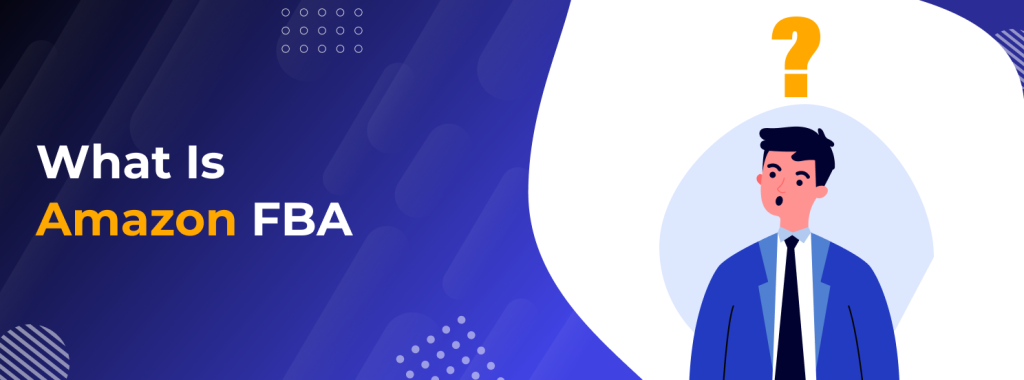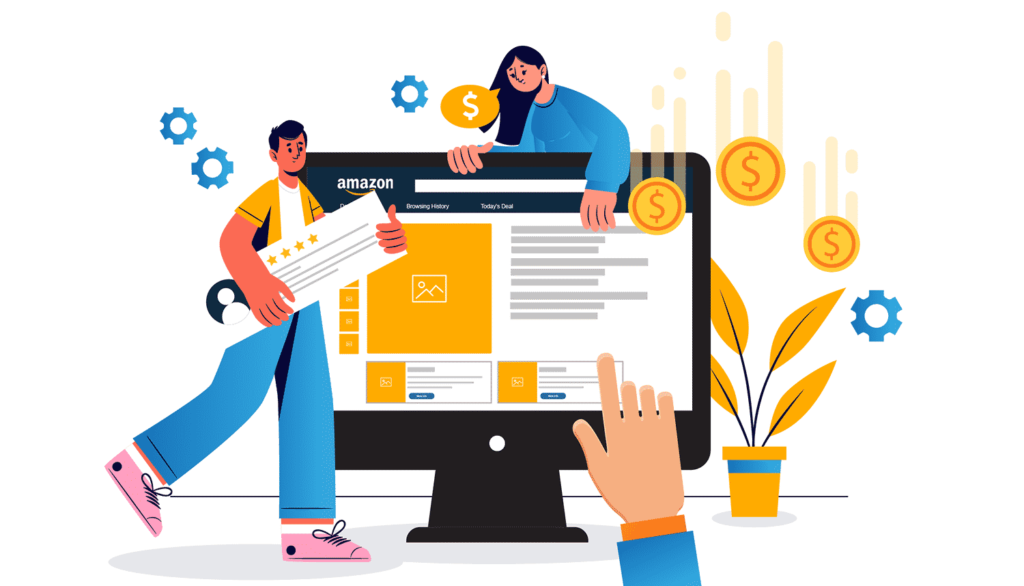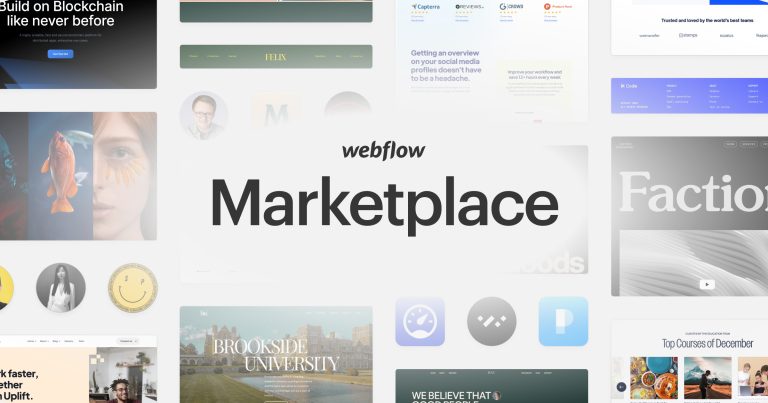Amazon FBA VS Dropshipping: Key Differences [2023]
Both Amazon FBA Vs Dropshipping constitute distinct e-commerce business frameworks. In both these approaches, merchants delegate the duties of warehousing and order completion, enabling them to dedicate attention to other facets of their enterprise.
Each model presents its own set of merits and demerits. Determining the optimal choice for your business hinges on several variables. These encompass the current status of your business, the extent of your financial resources, and your preferred degree of authority.
This article aims to dissect the disparities between Amazon FBA vs dropshipping, thereby aiding you in making an informed selection that aligns with the requisites of your e-commerce establishment.
What Is Dropshipping?

Dropshipping represents a fulfillment model within the realm of eCommerce that incorporates third-party entities, including retailers and manufacturers. This business approach has gained widespread popularity and is projected to achieve a market size of $26 billion by 2027.
This methodology empowers sellers to promote products and initiate online sales without the need to invest upfront in stock or manage inventory. When customers place orders online, the store proprietors transmit the order particulars to the third-party entities. Subsequently, the responsibility of shipping the products to customers is assumed by the retailer or manufacturer.
Dropshipping streamlines the process considerably, as the manufacturer undertakes the entire logistical chain right from the outset, thereby allowing you to concentrate on nurturing your brand. Nonetheless, commencing a dropshipping venture necessitates consideration of various factors, including market competitiveness, the specific dropshipping niche, suitable suppliers, and the legal prerequisites associated with launching your business.
What Is Amazon FBA?
 Amazon FBA functions as a service that simplifies the logistical aspects of product storage and shipping for businesses.
Amazon FBA functions as a service that simplifies the logistical aspects of product storage and shipping for businesses.
Through Amazon FBA, proprietors of eCommerce stores have the option to dispatch their merchandise to Amazon’s fulfillment center, alleviating the need for establishing their own storage facility. Subsequently, Amazon’s Warehouse manages the entire spectrum of product shipping, encompassing packing and delivery for each customer order.
By embracing Amazon FBA, sellers gain access to the Inventory Performance Dashboard, enabling them to vigilantly monitor factors influencing their Inventory Performance Index (IPI) score. Additionally, the seller toolkit can be utilized to address issues like surplus inventory, track the age of items in stock, update product listings, and effectively manage inventory levels.
Furthermore, this service extends shipping incentives to support FBA sellers in curtailing shipment costs, thus augmenting their profit margins.
Key Differences Between Amazon FBA vs Dropshipping

Amazon FBA (Fulfillment by Amazon) and dropshipping are both popular e-commerce business models, but they have significant differences in how they operate and the benefits they offer. Here are the key differences between Amazon FBA vs dropshipping:
-
Inventory Handling:
- Amazon FBA: With FBA, sellers ship their inventory in bulk to Amazon’s fulfillment centers. Amazon stores, picks, packs, and ships the products to customers. Sellers have control over their inventory, but Amazon handles the storage and shipping logistics.
- Dropshipping: In dropshipping, the seller doesn’t hold any inventory. Instead, they list products on their online store and only purchase items from a third-party supplier when a customer places an order. The supplier then directly ships the product to the customer.
-
Inventory Control:
- Amazon FBA: Sellers have more control over their inventory, including the ability to manage restocking, pricing, and branding. However, they still need to follow Amazon’s guidelines and requirements.
- Dropshipping: Sellers have less control over inventory and shipping. They rely on the supplier to maintain stock levels and handle shipping, which can sometimes lead to issues like products being out of stock or delayed shipments.
-
Fulfillment Speed:
- Amazon FBA: FBA products are eligible for Amazon Prime, which offers fast and reliable shipping to customers. This can lead to higher customer satisfaction due to quicker delivery times.
- Dropshipping: Shipping times in dropshipping can vary based on the supplier’s location and shipping methods. This can sometimes lead to longer delivery times compared to Amazon FBA.
-
Shipping Costs:
- Amazon FBA: While FBA provides fulfillment and shipping services, there are associated fees for storage, packing, and shipping. However, these costs are often offset by the convenience and efficiency of Amazon’s fulfillment network.
- Dropshipping: Dropshippers may have lower upfront costs since they don’t need to purchase inventory in advance. However, they might face higher per-unit costs due to buying from suppliers at retail prices.
-
Control Over Branding:
- Amazon FBA: Sellers can brand their products with customized packaging and inserts, enhancing their brand identity and customer experience.
- Dropshipping: Branding options are limited in dropshipping since products typically come directly from the supplier. This can make it harder to establish a unique brand presence.
-
Returns and Customer Service:
- Amazon FBA: Amazon handles customer service, returns, and refunds on behalf of the seller. This can simplify the process for sellers, but they still need to address certain issues and concerns.
- Dropshipping: Sellers need to handle customer service, returns, and refunds themselves, which can be more time-consuming and challenging.
-
Profit Margins:
- Amazon FBA: While FBA provides convenience and access to a large customer base, the associated fees can sometimes eat into profit margins.
- Dropshipping: Dropshippers might have higher profit margins on each sale since they often purchase products at lower prices. However, the lack of control over pricing and inventory can affect overall profitability.
Both models have their pros and cons, and the choice between Amazon FBA vs dropshipping depends on factors like your business goals, budget, level of control, and willingness to manage various aspects of the supply chain.
Pros and Cons of Amazon FBA VS Dropshipping
Pros and Cons of Amazon FBA
In this section, we will explore the key advantages and drawbacks of the Amazon FBA method.

Pros:
- Simplified Startup: Initiating the process requires just a handful of straightforward steps. Begin by setting up an Amazon FBA account and organizing your desired products into a listing within the FBA inventory. Subsequently, arrange and dispatch your products to Amazon’s fulfillment centers, allowing them to manage the shipping process.
- Streamlined Customer Support: Dealing with customer inquiries can consume a significant amount of time. However, with FBA, Amazon’s customer service handles all buyer inquiries. Customers can readily engage with Amazon’s support at any time, and you won’t incur extra FBA fees for utilizing this service.
- Instant Global Reach: Amazon FBA empowers eCommerce proprietors to expand their businesses to a worldwide audience. For instance, the FBA Pan-EU initiative facilitates prompt deliveries across European nations. Additionally, the FBA Export feature enables you to tap into markets in over 100 countries, fostering the growth of your online business.
- Seamless Returns and Refunds: Amazon’s FBA program includes well-defined customer return policies and offers assistance to clients seeking to return purchased items. Through the user-friendly online return center, customers can effortlessly initiate processes such as returns, refunds, replacements, and reimbursements.
Cons:
- Intense Competition: Given Amazon’s status as one of the globe’s premier selling platforms, you may encounter other enterprises offering comparable products at lower prices. To navigate this, thorough research is vital. Opt for high-demand products with minimal competition, and bear in mind that competing against seasoned Amazon sellers might necessitate heightened efforts.
- Unassured Profits: Not every product guarantees swift profitability for your venture. While some items might sell rapidly, employing effective eCommerce marketing strategies and establishing competitive pricing are essential for sustaining consistent profits.
- Platform-Exclusive Sales: Unlike alternative business models like dropshipping, your focus is solely on selling products through Amazon’s platform. Consequently, any alterations in the platform’s selling policies or the suspension of your Amazon account could significantly impact your eCommerce operation.
- Customer Ownership by Amazon: With the Amazon FBA business model, your customer base essentially belongs to Amazon’s ecosystem. This restricts your ability to leverage contact information for tailored campaigns, such as affiliate marketing or building an email list, which would otherwise enhance customer loyalty for your company.
Pros and Cons of Dropshipping on Amazon
Let’s delve into the advantages and drawbacks of employing the dropshipping model on Amazon. As we explore this, it becomes evident that there are compelling reasons both in favor of and against adopting dropshipping on this platform.

Pros:
- Minimal Initial Investment: One of the primary benefits of the dropshipping business model is its low startup cost. This is attributed to the fact that you’re not burdened with the manufacturing or stocking of products. Consequently, when embarking on your eCommerce venture, you can allocate more resources towards other essential aspects.
- Reduced Responsibilities: With this approach, your responsibilities primarily revolve around managing your eCommerce website and transmitting order details to your designated dropshipping supplier. The intricate process of product shipping becomes the supplier’s sole obligation, streamlining your business’s supply chain and enhancing operational efficiency.
- Geographical Flexibility: The dropshipping model empowers you to operate your online store from virtually any location. It’s crucial, however, to ascertain the legitimacy and accessibility of your chosen dropshipping supplier. This diligence prevents potential disruptions in product shipment that might lead to customer dissatisfaction and reputational harm.
- Zero Upfront Expenditure: Beyond the modest initial costs, the burden of day-to-day operations is effectively lifted off your shoulders, thanks to the comprehensive support provided by your supplier. Additionally, there’s no necessity to engage with extensive third-party logistics companies. Consequently, dropshipping proves to be an ideal avenue for entrepreneurs with limited financial resources.
Cons:
- Narrow Profit Margins: While the dropshipping model facilitates a budget-friendly commencement, it tends to yield slimmer profit margins. The necessity to allocate a certain portion of your earnings to your supplier, coupled with potential limitations in upselling, can restrict your potential earnings. Customers may seek alternatives that offer superior value, which could erode your profitability.
- Intense Market Competition: Given the popularity of dropshipping in the eCommerce landscape, competition within the field is notably fierce. It’s conceivable that you’ll encounter competitors peddling similar or even identical products, often at lower price points. This competitive landscape could necessitate strategic differentiation and customer engagement efforts.
- Reliance on Manufacturers: The dropshipping arrangement means you don’t possess ownership of the products you’re vending. This implies a dependence on your supplier’s information, especially when addressing customer inquiries. However, suppliers might occasionally provide inaccurate shipping details. Additionally, in cases of complex customer queries, you might be compelled to cross-verify with your suppliers, inevitably elongating response times.
- Limited Control over Product Quality: A central drawback of dropshipping is the limited control you exert over product quality. Manufacturers oversee every step from packaging to delivery, effectively limiting your ability to inspect outgoing products closely. Thus, the pivotal task becomes selecting a reliable third-party supplier. A prudent approach involves initially procuring items from them as a client to gauge their trustworthiness.
Amazon FBA vs Dropshipping: Which Is More Cost-friendly?

When comparing Amazon FBA vs Dropshipping in terms of cost-effectiveness, there are significant differences to consider. Regarding costs:
Amazon FBA (Fulfillment by Amazon) requires an upfront investment in purchasing and storing inventory. This can tie up a substantial amount of capital, especially if you’re offering a diverse range of products. You’ll also have to cover Amazon’s packaging and shipping fees, along with other selling-related charges.
On the other hand, the Dropshipping model doesn’t necessitate upfront inventory purchases. You only buy products from suppliers when you receive orders, reducing initial costs. While you can avoid substantial investment in inventory, the costs of purchasing from suppliers might be higher compared to sourcing products in bulk for Amazon FBA.
Dropshipping also comes with higher shipping costs, as you’re sending products directly from suppliers to customers, leading to more complex shipping cost calculations. However, you won’t have to pay storage and packaging fees as you would with Amazon FBA.
In summary, Dropshipping generally boasts lower initial costs and potential short-term cost savings due to the absence of upfront inventory investment. However, shipping costs and supplier product pricing should be considered. Amazon FBA might be more suitable when aiming for business expansion and higher control over the delivery process, despite initial costs and Amazon’s service fees. Choosing between the two models depends on your business strategy, the products you’re selling, financial circumstances, and your ability to manage inventory and shipping.
How to Choose Between Amazon FBA vs. Dropshipping
Having gained an understanding of the distinctions within the extensive deliberation between “Dropshipping vs FBA,” it’s now time to determine which strategy aligns most suitably with your circumstances. To help you make this decision, consider the following inquiries:
- What is your level of experience? – If you’re relatively new to the realm of online selling, opting for dropshipping might be more advantageous. This approach allows you to experiment with diverse products and acquire insights into effective strategies.
- What is your available budget? – Should your financial resources be relatively limited (under $5,000), embracing dropshipping could be more feasible owing to its reduced costs.
- How much effort are you willing to invest? – If you prefer to avoid the responsibilities of managing customer service and overseeing product shipments, the Amazon FBA route presents a more favorable avenue.
- What is your growth ambition? – If your aspirations involve establishing a distinct brand presence and conducting substantial sales, Amazon FBA emerges as the superior alternative. This route facilitates the opportunity to sell in larger quantities and foster your own unique brand identity.
Final Thoughts
Both Amazon FBA vs dropshipping offer unique and captivating business opportunities. Your expertise and focus determine which path aligns best with your goals.
In brief, for a gradual approach with modest investment, opt for dropshipping. If you’re aiming for ambitious growth and a robust eCommerce venture, Amazon FBA is your avenue.
We’ve provided comprehensive insights into both models, aiming to bring you valuable information. If any aspects are missing, feel free to comment, and we’ll promptly address them. We’re also eager to hear about your choice between dropshipping and Amazon FBA for your future business endeavors.
Reach out to us – ONEXT DIGITAL to discuss sourcing products for your dropshipping or Amazon FBA venture. We’re here to assist you on this journey.




